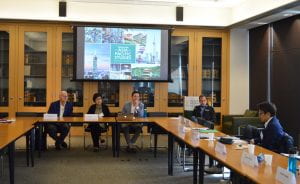The USF Center for Asia Pacific Studies invited 12 scholars to campus to present their research on the topic at the center’s fall symposium, “Have You Eaten Yet? The History and Culture of Food in East Asia” (October 17-18, 2019). Scholars from Asia, the US, and Canada came to campus to participate in the symposium and engage with local faculty, independent scholars and USF graduate students. The topics were wide-ranging, for example, the globalization of Asian cuisines, the impact of transportation on food writing, and the growing importance of restaurant guidebooks in China.
Creating the Modern Chinese Diet
The first panel of this two-day event focused on how scholars in early modern and modern China viewed healthy eating and constructed guidelines for the Chinese Diet. Prof. Hilary Smith (University of Denver) presented a history of modern nutritional knowledge in China. Her research into Ding Fubao’s dietary guidelines in late Qing China revealed how Ding combined pre-existing nutritional knowledge with recently introduced western conceptions of health. Next, Miaosi Zhang (Pennsylvania State University) explored the early modern Chinese concept of “nourishing life.” Zhang’s presentation examined how the late Ming literati class viewed maintaining one’s health through eating and drinking as part of their elite lifestyle.
Considering How Food is Envisioned
In the second panel, Prof. Amy Marshall (Florida International University) examined food and cooking through the lens of Japanese family magazines (katei zasshi). Her research demonstrated how recipes and cookery changed over time (especially during wartime) and revealed how these magazines were used to spread a national ideology. Prof. Joshua Schlachet (University of Arizona) explored how the Japanese viewed food as central to healthcare during the Meiji era. Sarah Zanolini (John Hopkins University) closed out the discussion with a study focused on how new world crops were assimilated into early modern Chinese diets. Zanolini revealed how crops like corn were initially labeled as foreign but were considered endemic by the 18th century.
Expanding Palates: Social Organization of Taste
After lunch and the chance to network with fellow scholars, Tatsuya Mitsuda (Keio University) presented his research on the role of Korea and China in the construction of meat-based cuisines in 20th century Japan. His comparisons of pre and postwar meat production and consumption demonstrated a decline in the consumption of Japanese beef and culinary diversification as Japan expanded its reach throughout the region. Prof. Eric Rath (University of Kansas) then took symposium participants on a journey, via “walkers’ guides to dining” first published in Japan in 1929. His presentation examined how mass transportation changed food writing in the interwar years in Japan. Next, Prof. Lisa Yoshikawa (William Smith Colleges) shared her findings on how new scientific knowledge of animals reflected what people considered to be acceptable to eat in imperial Japan. Ranging from amphibian stews to fried insects, these animal delicacies and “bizarre eats” challenged the Japanese to become more adventurous eaters, especially during times of scarcity. Last, Prof. Willa Zhen’s (Culinary Institute of America) research brought us back to the contemporary period with a presentation that encouraged us to consider who gets to choose what tastes good. Prof. Zhen’s research examined the Michelin Guide and the construction of taste in Guangzhou and considered if the French publication’s standards can truly evaluate the local cuisines of China.
The Globalization of Japanese Cuisine
On day two of the symposium, Prof. James Farrer (Sofia University) examined the culinary politics of Japanese food by looking at the global expansion of Japanese restaurants in Europe. His research encouraged reflection on the crisis faced by Japanese people losing monopoly over their cuisine and the rapid spread of non-Japanese owned Japanese restaurants as an example of global success or cultural appropriation. Next, Prof. Yasue Kuwahara (Northern Kentucky University) presented the “transnational adventure of sushi” using the framework of globalization, glocalization, and bipolarization. Her presentation revealed the links between the spread of sushi in the US and the production of Japanese rice varieties in California. In the last panel of the day, Dr. Christopher Laurent (University of San Francisco) presented his research on Korean cuisine in contemporary Japan. He traced this cuisine back to the Korean diaspora to Japan, the exclusion of the Zainichi Korean residents in Japan, and how their food is being appropriated and sold as Japanese cuisine.
Symposium participants were invited to submit their papers for consideration by the center’s open access, peer-reviewed journal, Asia Pacific Perspectives. The journal is currently expecting symposium participant submissions as well as other articles for a special issue on food and culture in East Asia to be published in Spring of 2020. To learn more about the journal, please visit: https://www.usfca.edu/center-asia-pacific/perspectives/v16n1 .

